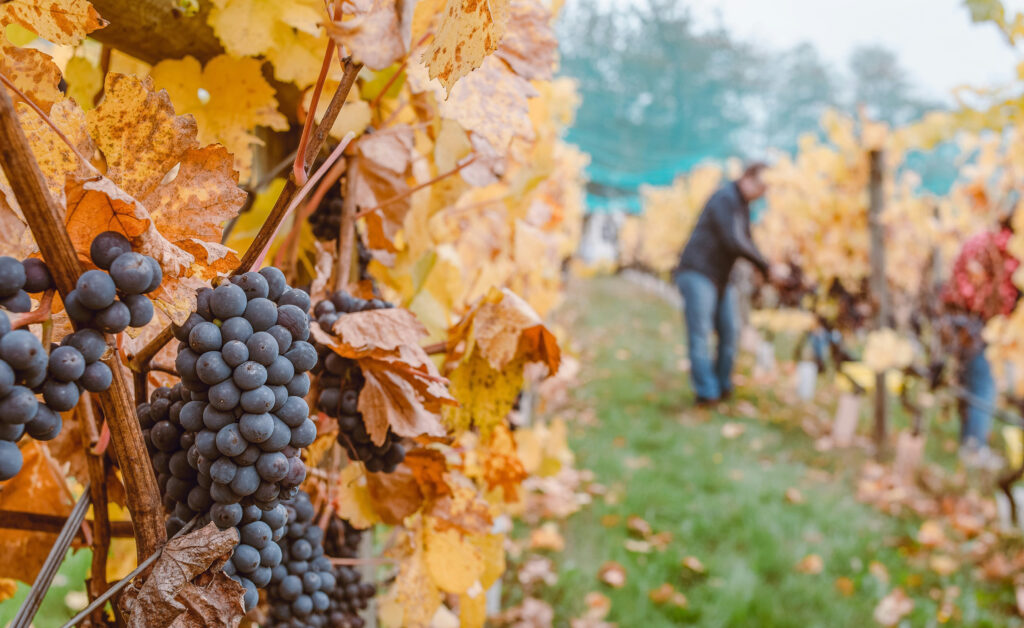Words Richard Hope
Picture this: a crisp winter’s day in Vancouver at the International Wine Festival. California and Oregon winemakers out in force, toasting partnership and “brotherly love”
with their B.C. counterparts.
On Thursday, February 27, the mood was downright celebratory. American growers talked about supporting B.C.’s wine industry with much-needed grapes. We were all friends here, raising glasses to cross-border kinship.
Then came Saturday, and the Trump administration announced sweeping tariffs on Canadian products. By the afternoon, there was no American wine to be found at the festival store.
The Trump administration’s tariffs hit like a bad hangover. Canada – long the U.S.’s most important wine export market – essentially shut the door. From April 2024 to April 2025, U.S. wine imports dropped 98% – a catastrophic collapse for the industry. This follows significant falls in exports from the U.S. to the U.K. (29%) and Japan (23%).
For winemakers in California, the timing couldn’t be worse. Whereas in B.C. there aren’t enough grapes to make wine, in California, there aren’t enough customers. Health-conscious consumers are not buying wine in the same quantities as their parents and grandparents. Wine also remains stubbornly expensive in bars ($15 a glass, anyone?) and choosing the right wine for the right time can often stump the average buyer.
Ironically, this year provided perfect growing conditions. The rebound from the California drought continued over the winter, piling the Sierra Nevada with snow perfect for the long melt across the summer. Cool conditions throughout the year enabled grapes to mature slowly, creating what could be a fantastic vintage.
The problem is there’s now a glut of grapes and grape juice. All this excess inventory means winemakers must lower prices to move product, even if it means tighter margins. Recent reporting in the Wall Street Journal revealed that Jackson Family Wines (who own brands like La Crema – one of the biggest-selling wines in America) had reduced the price of a bottle by about US$1.50. The SVP of Marketing at the company revealed: “We see this magic line of US$19.99″ as the target price for a bottle of wine. Whilst it might be harder to find U.S. wine in Canada, there’s no mistake that it remains great value for money.
The challenges in California reflect changing consumer preferences worldwide. The combination of inflation and shifting demographics heralds a far smaller market for wine going forward. Global wine consumption now sits at levels not seen since the early 1960s. This April, The International Organisation of Vine and Wine (OIV) reported that the average consumer “was now paying about 30% more for a bottle than in 2019.”
Here’s the paradox: as consumers spend less overall, when they do buy a bottle, they pay more. The mid-to-top range of the wine market is growing, even as the broader market declines.
B.C.’s Opportunity
Is there a way forward for the wine industry facing these challenges? The B.C. example might offer a blueprint. In response to the Trump administration’s tariffs, the government has pushed hard on a “Buy Canadian” marketing campaign. At many liquor stores, the U.S. aisle has been replaced with rows of local Canadian products. In Ontario, the LCBO has reported that sales of wine featuring the Vintners Quality Alliance (VQA) logo have risen 60% since U.S. products were removed. The VQA label demonstrates the wine was produced using local grapes and manufactured locally – in Ontario or B.C.
There’s a certain poetic justice to it all. That Thursday at the wine festival, we were the grateful neighbours, dependent on American generosity. Today, B.C. wine is staking its claim – not as California’s little cousin, but as a distinct and worthy competitor. Our cooler climate produces elegant, food-friendly wines that deserve shelf space on their own merits, not just as gap-fillers when imports dry up.
Editor’s Pick: South of the Border Recommendation
Ridge Vineyards – Lytton Estate Dry Creek Valley Petite Sirah 2019
If you can find it, Ridge Vineyards products are some of the best wines you can buy on the West Coast. Their blended wines are spectacular (including their Three Valleys – Sonoma County bottle). A fantastic gift – I highly recommend their wines, though they’re increasingly rare north of the 49th parallel.




